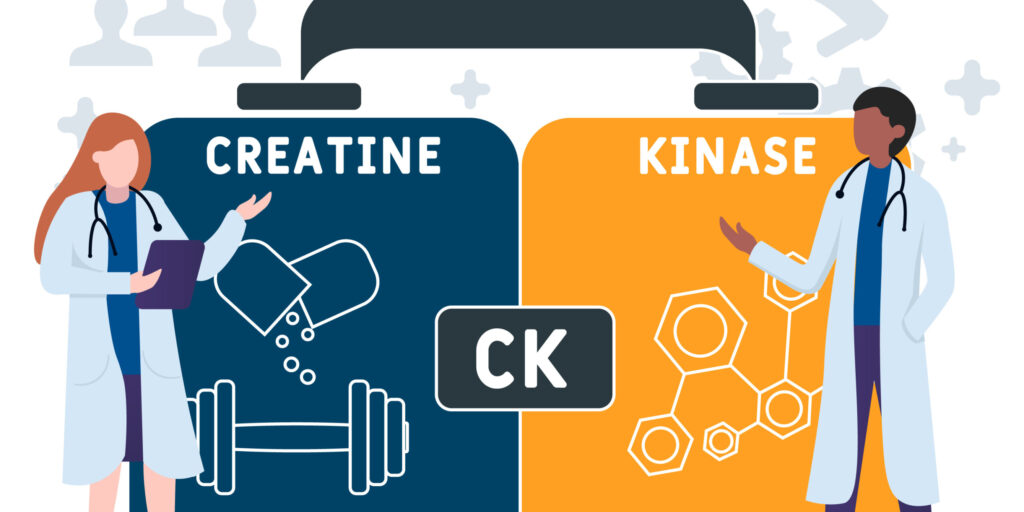
Simply Stated: The Creatine Kinase Test
By Sharon Hesterlee, Ph.D. | Thursday, March 7, 2024
5 Second Summary
“Simply Stated” is a Quest column designed to explain some terms and basic facts about neuromuscular diseases.
Find more at Mdaquest.org/tag/simply-stated
Almost everyone with a neuromuscular disease has had, or will have, a creatine kinase test. But what exactly is creatine kinase (CK), and why are its levels measured in neuromuscular diseases?
CK, also known as phosphocreatine kinase, or CPK, is a type of protein called an enzyme. It catalyzes, or “encourages,” a biochemical reaction to occur. The normal function of CK in our cells is to add a phosphate group to creatine, turning it into the high-energy molecule phosphocreatine. Phosphocreatine is burned as a quick source of energy by our cells.
However, the normal function of CK is not as relevant, in this case, as what happens to CK when muscle is damaged. During the process of muscle degeneration, muscle cells break open and their contents find their way into the bloodstream. Because most of the CK in the body normally exists in muscle, a rise in the amount of CK in the blood indicates that muscle damage has already occurred or is currently occurring. Thus, a rise in blood CK levels is usually a marker for either muscle injury, disease, or inflammation.
CK levels as a diagnostic tool
To measure CK levels, a blood sample is taken and separated into fractions that contain cells and a fraction that does not — the serum. The amount of CK in the serum is reported in units (U) of enzyme activity per liter (L) of serum. In a healthy adult, the serum CK level varies with a number of factors (gender, race, and activity), but normal range is 22 to 198 U/L (units per liter)1. The values reported for what is considered a healthy range of creatine kinase can also vary across different laboratories.
Higher amounts of serum CK can indicate muscle damage due to chronic disease but can also be a result of acute muscle injury. For this reason, if you’re scheduled to have blood drawn for a CK test, you should limit your exercise to normal activities before the test.
CK tests are often the first step in a series of tools that are used to diagnose neuromuscular disease. CK tests are used to evaluate the possibility of neuromuscular diseases in six basic ways:
- To confirm a suspected muscle problem before other symptoms occur
- To determine whether symptoms of muscle weakness are caused by a muscle or a nerve problem
- To differentiate between some types of disorders, such as dystrophies versus congenital myopathies
- To detect “carriers” of neuromuscular disorders, particularly in Duchenne muscular dystrophy. A carrier has a genetic defect but does not get the full-blown disease. A carrier’s child may have the full disease.
- To follow the course of a disease that fluctuates (primarily the inflammatory myopathies), or to document episodes of acute muscle injury, as might occur in some metabolic myopathies.
- In neonatal screening for early diagnosis of certain diseases, such as Duchenne muscular dystrophy
Understanding elevated CK levels
Because elevated CK levels indicate muscle damage, many parents wonder why their children with Duchenne muscular dystrophy (DMD) had higher CK levels when they were younger and had more muscle function2. This seeming paradox occurs because muscle degeneration is more rapid at the earlier stages and, possibly, because there’s more muscle bulk available to release CK into the circulation at that time.
CK levels can be slightly elevated (500 U/L) in nerve disorders like Charcot-Marie-Tooth (CMT), amyotrophic lateral sclerosis (ALS), or spinal muscular atrophy (SMA), or grossly elevated (~3,000 to >30,000 U/L) in DMD, some other muscular dystrophies or inflammatory myopathies3 (dermatomyositis, polymyositis, and inclusion-body myositis). At the same time, some neuromuscular disorders, such as the congenital myopathies (nemaline, central core disease, and others) and myasthenia gravis, may not trigger any elevation of CK levels.
During episodes of acute muscle breakdown (rhabdomyolysis), such as may occur in some inflammatory and metabolic myopathies, CK levels can temporarily go off the scale, topping out at 50,000 to 200,000 U/L. This would usually constitute a medical emergency and the patient would be treated at the hospital. In these situations, CK levels are much higher than those seen in cases of chronic elevation, such as in the muscular dystrophies.
It is important to note that CK levels don’t always reflect the level of functional impact on the individual. There is a lot of variability and there are a lot of factors that can affect CK levels, and high CK values does not confirm a diagnosis of a neuromuscular disease. It is usually a doctor’s first indication that there might be an issue and is followed up by a genetic testing ordered by your doctor.
Additional Information and Resources:
- “Effect of newly proposed CK reference limits on neuromuscular diagnosis”
Rachel A Nardin , Amy R Zarrin, Gary L Horowitz, Andrew W Tarulli
Muscle Nerve, 2009: 39(4):494-7
- “Serum creatine-kinase (CK) and pyruvate-kinase (PK) activities in Duchenne (DMD) as compared with Becker (BMD) muscular dystrophy”
M Zatz , D Rapaport, M Vainzof, M R Passos-Bueno, E R Bortolini, R de C Pavanello, C A Peres
J Neurol Science, 1991 Apr;102(2):190-6
- “Spectrum of Neuromuscular Disorders With HyperCKemia from a Tertiary Care Pediatric Neuromuscular Center”
Fouad Al-Ghadir , Basil T Darras , Partha S Ghosh
J Child Neurol. 2018; 33(6):389-396
Next Steps and Useful Resources
- Learn more about key diagnostic tests for neuromuscular diseases
- Learn more about the difference between clinical and genetic diagnosis
- When you’re searching for a diagnosis, ask your doctor these questions.
- Learn more about the many neuromuscular diseases MDA covers in the Quest Media Diseases A-Z content library.
- Stay up-to-date on Quest content! Subscribe to Quest Magazine and Newsletter.
Disclaimer: No content on this site should ever be used as a substitute for direct medical advice from your doctor or other qualified clinician.




